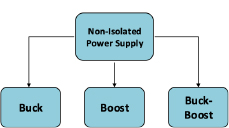This tutorial explains the AC to DC conversion process and why it is necessary. The electricity that is delivered to our home is mainly AC (Alternative Current). Different countries have different standards for household AC lines that range from 100V to 220V. Even so, most home appliances are operated by DC (Direct Current), although devices such as motors and incandescent bulbs are AC. Therefore, the electricity we receive at home is AC, necessitating the need for an AC-DC converter to operate DC devices.
AC-DC conversion topologies – isolation
Non-isolated power supply
In this converter, one of the main AC lines is common at the input and output. This is why they do not provide isolation between 220V AC and the output. The advantages of non-isolated power supplies include simplicity of design, need for fewer components, lower cost, and small size. The disadvantage is the increased risk of electric shock.
Isolated power supply
These types of converters use a transformer for converting AC to DC. The transformer provides isolation or protection between the high voltage AC lines and the output in case of a short circuit. Although they are safer to use, there is a higher cost due to the transformer, the circuits tend to be more complex and are larger than non-isolated power supplies.
Switching frequency – t transformer system
This is the basic method for converting AC to DC. At the input, a step-down transformer transforms the 220 V AC into a lower AC voltage (such as 24 V) and, through filters and ICs, a regulated DC is obtained. This method tends to be less complex and generates less noise, but it is also larger in size and less efficient due to additional heating losses. Below is the step-by-step process of this approach.

Figure 1: AC to DC Conversion Using Filter and Transformer
For more detailed information on this approach, see previous experiments on power supplies.
Switching topology
The basic idea behind this topology is to reduce the size of the circuit by increasing the switching frequency. Therefore, this topology does not use a 50 Hz transformer on the input side, which reduces the overall size of the circuit as well as the cost. Basically, high AC voltage (at 50 Hz) is converted into DC signal through rectification and filtering. The DC is then cut into a high frequency ON OFF AC pulse (in KHz) by the switching circuit; the DC is then reconverted back to low-level DC by rectification and filtering. The advantages of this topology include small size, good efficiency and lower heat dissipation; however, it is complex to design and results in high switching losses.

Figure 2: Representation of the switching topology principle
The switching topology is again implemented in two ways:
- Non-Isolated – In this method, we will not use any transformer in the circuit, which makes a common AC line for both input and output. These sources use only one switching IC with some passive and active components, which makes them less expensive. These systems can be used in LED lighting, adapters, etc., where there is no danger to human life.
- Isolated – In these types of power supplies, the circuit uses a high-frequency transformer, and the transformer provides galvanic isolation to the circuit. In this isolation, the signal can pass through the transformer, but the AC current and high voltage are blocked. It is mainly implemented in medical equipment and home devices.
Main types of non-isolated power supply

Fig. 3: Various types of non-isolated power supply
For AC-DC or DC-DC conversion, these are some commonly used power supplies. We have already designed the DC-DC converter power supply. For more details on this, see the SMPS power supplies tutorial.
Now, we will design a non-isolated AC-DC converter power supply in this series of experiments.
Main types of isolated power supply

Fig. 4: Various types of isolated power supply
These sources use high frequency transformers. Some converters also use transformers as energy storage elements. An example of such a converter is the flyback converter, where the transformer is specially designed for energy storage.

